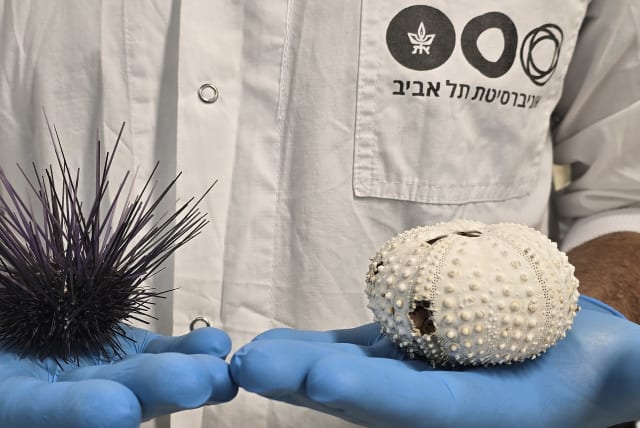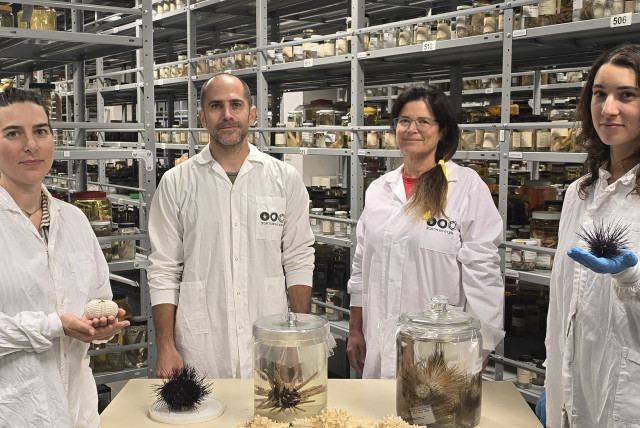Deadly sea urchin epidemic spreads, causes major threat to coral reefs

Tel Aviv University experts warn: A deadly epidemic among sea urchins in the Red Sea has spread to the Indian Ocean, posing a major threat to coral reefs around the world.
Sea urchins – spiky-skinned invertebrates that can be found in all the world’s oceans and first appeared about 450 million years ago – are regarded as protectors and gardeners of coral reefs.
Unfortunately, they are now suffering from a deadly epidemic in the Red Sea that has spread to the Indian Ocean and could become a global pandemic damaging and destroying coral reefs all over the world.
The Tel Aviv University (TAU) research team that in December 2022 first discovered the phenomenon in Eilat was able to identify the pathogen responsible for the epidemic.
Then, the pathogen essentially wiped out Eilat’s most abundant and ecologically significant sea urchins.
A threat of a new global pandemic
According to the researchers, what appeared at first to be a severe but local epidemic has rapidly spread through the region and now threatens to become a global pandemic.
Sea urchins feed on the algae that compete with the corals for sunshine, and their disappearance can severely impact the delicate balance of coral reefs globally.
The researchers added that since the discovery of the epidemic in Eilat's coral reefs, the two species of sea urchins previously most dominant in the Gulf of Eilat have completely disappeared.
Sea urchins are brainless and unable to swim; instead, they live on the seafloor and are attached with “tube feet” (suckers) to coral and rocks and swept away by the currents.
The study, just published in the journal Current Biology under the title “Mass mortality of diadematoid sea urchins in the Red Sea and Western Indian Ocean,” was led by Dr. Omri Bronstein from TAU’s School of Zoology and the Steinhardt Museum of Natural History (SMNH), together with research students Lachan Roth, Gal Eviatar, Lisa Schmidt, and May Bonomo, as well as Dr. Tamar Feldstein-Farkash from the SMNH.
Research partners throughout the region and Europe also took part in the study, which encompassed thousands of kilometers of coral reefs.
By using molecular-genetic tools, the team was able to identify the pathogen responsible for the mass mortality of sea urchins of the species Diadema setosum in the Red Sea: a scuticociliate parasite most similar to Philaster apodigitiformis.
The researchers explain that this unicellular organism was also responsible for the reoccurring mass mortality of Diadema antillarum in the Caribbean Sea about two years ago, following the notorious 1983 sea urchin population collapse there, which led to the catastrophic phase shift of the coral reef.
Bronstein was the first researcher to identify mass mortality of sea urchins of the species Diadema setosum – the long-spined black sea urchins that were very common in the northern Gulf of Eilat, Jordan, and Sinai.
He and his team also found that the epidemic was lethal for other, closely related sea urchins from the genus Echinothrix. These results suggest that the once-abundant and significant seabed herbivores in the region are now practically gone.
Thousands of sea urchins suffered a quick and violent death; within two days, a healthy sea urchin turned into a skeleton with no tissues or spines, and most were devoured by predators as they were dying, unable to defend themselves.
According to estimates, today, only a few members of the affected sea urchin species remain throughout the coral reefs of the Gulf of Aqaba.
The most significant and widely studied mass death of the invertebrates spread through the Caribbean, killing most sea urchins of the species Diadema antillarum – relatives of Eilat’s sea urchins.
The algae spread uncontrollably, blocking the sunlight from the corals, and the entire reef was transformed from a coral reef into an algae field.
Even though the mass mortality event in the Caribbean occurred four decades ago, both the corals and the sea urchin populations never fully recovered, with repeated mortality events observed through the years.
“This is a growing ecological crisis, threatening the stability of coral reefs on an unprecedented scale,” said Bronstein. “Apparently, the mass mortality we identified in Eilat back in 2023 has spread along the Red Sea and beyond – to Oman and even as far as Reunion Island in the Indian Ocean.”
Israeli research team first to make documentation
The TAU team was the first to document all stages of the disease – from infection to the inevitable death – with a unique video system installed at Eilat’s Interuniversity Institute for Marine Sciences. “Moreover, until recently, only one species of sea urchins was known to be impacted by this pathogen – the Caribbean species.
Today, we know that additional species are susceptible to the disease – all belonging to the same family of the most significant sea urchin herbivores on coral reefs,” Bronstein said.
They also showed that the epidemic is spreading along routes of human transportation in the Red Sea. The best example is the wharf in Nueiba in Sinai, where the ferry from the Jordanian city of Aqaba docks.
When they published their report last year, they already knew of sea urchin deaths in Aqaba but had not yet identified signs of it in Sinai.
The first spot in which we ultimately did identify mortality in Sinai was next to this wharf in Nueiba. Two weeks later the epidemic had already reached Dahab, about 70 kilometers to the south.
“The scene underwater is almost surreal: seeing a species that was so dominant in a certain environment simply erased in a matter of days. Thousands of skeletons are rolling on the sea bottom, crumbling and vanishing in a very short time, so even evidence of what has occurred is hard to find,” Bronstein said.
There is currently no way to help infected sea urchins or vaccinate them against the disease. “We must, however, quickly establish populations of endangered species in cultivation systems disconnected from the sea – so that in the future we will be able to reintroduce them into the natural environment.”
Unfortunately, he concluded, “We cannot repair nature, but we can certainly change our own behavior. First of all, we must understand what caused this outbreak at this time. Is the pathogen transported unknowingly by seacraft, or has it always been here, erupting now due to a change in environmental conditions? These are precisely the questions we are working on now.”
Jerusalem Post Store
`; document.getElementById("linkPremium").innerHTML = cont; var divWithLink = document.getElementById("premium-link"); if (divWithLink !== null && divWithLink !== 'undefined') { divWithLink.style.border = "solid 1px #cb0f3e"; divWithLink.style.textAlign = "center"; divWithLink.style.marginBottom = "15px"; divWithLink.style.marginTop = "15px"; divWithLink.style.width = "100%"; divWithLink.style.backgroundColor = "#122952"; divWithLink.style.color = "#ffffff"; divWithLink.style.lineHeight = "1.5"; } } (function (v, i) { });

